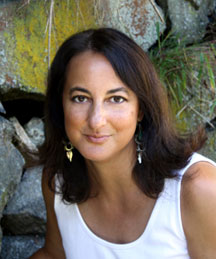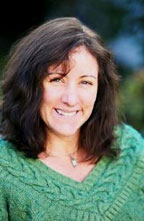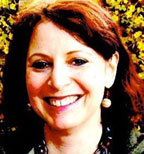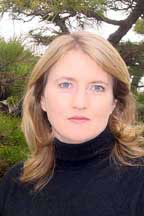
e may well be entering the Golden Age of Flash Fiction. Now that there is a cell phone in every pocket, and our attention spans are on the decline (not to mention lack of ample time for digging into massive tomes), flash fiction is ideally suited to the modern reader. In Japan, entire novels are published serially, bit by bit, on cell phone screens; and reading apps for small digital devices have popped up in the United States as well. To get a grip on what’s happening in the world of flash fiction, I talked to four experts, including literary agent Andrea Hurst,
the judge of WOW’s Fall 2011 Flash Fiction Contest; Tara Masih, author of Where the Dog Star Never Glows (Press 53), a finalist for USA Book News Best Books Award, and editor of The Rose Metal Press Field Guide to Flash Fiction and The Chalk Circle, a collection of prize-winning intercultural essays; Stefanie Freele whose short story collection, Feeding Strays (Lost Horse Press),
was a finalist for both the Book of the Year Award and the 2010 Binghamton University John Gardner Fiction Book Award; and Meg Pokrass, author of the flash fiction collection Damn Sure Right (Press 53) and editor-at-large for Blip Magazine. Freele and Masih have both served as judges for the Press 53 Open Awards. Currently, Pokrass is judging Press 53’s 2012 Open Awards in the flash fiction category.

“To me, flash is an art form; it appeals to my desire to reduce reality into something made more wondrous by virtue of its condensed size.”
(Photo: Tara Masih)
WOW: How would you define flash fiction?
Stefanie: I mention flash fiction as that around or under about 1000 words. You’ll hear many terms; microfiction, quick fiction, short shorts, etc.
WOW: I think there’s some confusion about the various forms of very short fiction. What do you think is the difference between a prose poem, microfiction, flash fiction, and short shorts?
Stefanie: This is just my little understanding; I’m sure there are a variety of strong opinions on this subject. I think of the prose poem as one that is more language-filled, perhaps more lyrical, more emphasis on lovely, perhaps one that captures a philosophy or a thought or a scene, a glimpse, has the possibility of being true with less emphasis on a story. I think of flash fiction as an untrue, very brief story. Microfiction—I think of a very small, but powerful, burst—a few lines, less than 250 words.
Tara: The prose poem pays more attention to the rhythm and lyricism of the piece. As for the rest, I don't see any difference, but in length.
WOW: As a writer with an idea, how do you decide which form a story will take (i.e., flash or fully fleshed out story)?
Stefanie: I rarely begin my writing knowing how the story will form. More than likely, a tiny crumb of something, like a piece of dialogue or an image, and I know I need to write about it. The story shows up as I write. Where the story comes from is often news to me.
Tara: I usually sense ahead of time how much material I have or will eventually have to tell a story. There are times when I know I need many pages and scenes to flesh something out, and other times when I just have a small scene, image, kernel of story that will only last the length of a flash. Sometimes, too, I deliberately choose to tell a story in miniature because at that moment the idea of challenging myself in such a confined space is more appealing to me than writing in a more traditional format.
WOW: What do you like about flash fiction?
Tara: Precisely what I mention above. I love the miniature aspect of it. I’ve always been fascinated with small things, and the tinier, the better: art on pinheads, carved rice grains, flea circuses, those peephole vista scenes in sugar eggs, The Borrowers. I collected anything I came across that was tiny. (I have some fairytale books that are 1 ½” x 2”.) To me, flash is an art form; it appeals to my desire to reduce reality into something made more wondrous by virtue of its condensed size.
Stefanie: I am a mother of a five-year-old; and as all mothers know, getting time to oneself isn’t easy; heck, isn’t that what the bathroom door is for? (Pound, pound. “Mama! Mama!”) I read tons of flash during the time he was a toddler, read it when I could in those teensy moments of solitude. Flash fiction fits in for the person who wants to disappear for a few minutes into another world, but doesn’t have the afternoon to lose oneself in the novel.
Bruce Holland Rogers is the one who revealed the world of flash fiction to me; he was my thesis advisor at the Northwest Institute of Literary Arts: Whidbey Workshop. There, we read some fantastic work in his Short Forms class, many of which still remain on my favorite’s shelf: Brevity and Echo (Rose Metal Press), Great American Prose Poems (edited by David Lehman, Scribner Poetry), In Brief: Short Takes on the Personal (Norton), You Have Time for This (Ooligan Press).

“Flash fiction fits in for the person who wants to disappear for a few minutes into another world.”
(Photo: Stefanie Freele)
WOW: In your opinion, what are the hallmarks of a good flash fiction story?
Tara: You read the first line, and you’re caught. You are propelled to the end. And then you pause in awe . . . and read again.
WOW: Meg, you’ve served as judge for quite a few flash fiction contests. What do you look for when choosing a winner?
Meg: I look for not needing to look! I look to be grabbed—when a piece is successful no searching or hunting seems to take place. It picks me, I don’t pick it.
When reading through a pile of stories, a few of them will not give me the chance to turn away. It is like hypnotism, from the first line. The story owns my attention. And I have to know what happens.
There is no magical answer to why this happens sometimes and not others. Each story is unique in its way of capturing attention and emotional involvement.
WOW: What mistakes do wannabe writers of flash fiction commonly make?
Meg: They think what grabs an editor’s attention is sex, especially (these days) bizarre sex or trendy sex and explicit (“brave”) language. They think what grabs attention is fancy ways of mixing words and word-sorcery, like exotic drinks with no emotional content. They think if it’s not easily understood then it is deep. They tell us what is happening and then how to feel and think. They draw characters that are black and white, no gray.
Flashes from literary agent Andrea Hurst
WOW: In judging WOW's recent flash fiction contest, was there anything that surprised you?
Andrea: The quality of writing was quite good. I was surprised by how much story and emotion could be contained in a short piece of fiction.
WOW: What were you looking for when choosing a winner?
Andrea: Memorable, moving, well-written pieces.
WOW: How does the future look for flash fiction?
Andrea: I think it will always be a genre people enjoy reading and writing.
WOW: Can you name a few recent favorite flash collections?
Tara: Recent? Well, Randall Brown reissued his wonderful Mad to Live; Meg Pokrass collected an amazing amount of high-quality, inventive flash in Damn Sure Right; and the Mother of Flash, Pam Painter, with her stunning collection, Wouldn't You Like to Know. And I haven't read it yet, but heard good things about Kathy Fish’s Wild Life.
Stefanie: Kathy Fish’s Wild Life, Michelle Reale’s If All They Had Were Their Bodies, Randall Brown’s Mad to Live—just to name a few. Also, even though Russell Edson is classified as a poet, he is one of my favorite short prose writers. See Jack is a terrific and hilarious collection as is all of Edson’s work. I’ve recently been introduced to Charles Goodrich, also a prose poet, and I’ve enjoyed studying his work, Going To Seed-Dispatches from the Garden; he does something magical and well thought-out in his short pieces.
Meg: Off the top of my head, here are some of my favorite flash fiction writers: Jayne Ann Phillips, Lydia Davis, Amy Hempel, Tara Masih, Molly Giles, Christopher Merkner, Frances Lefkowitz, Jeff Landon, Grant Bailie, Pamela Painter, Thaisa Frank, James Robison, Tiff Holland, Angie Becker-Stevens, Michael Czyzsiejewski, and Andrew Roe . . . but there are so many more! Not many collections of these yet. In fact, there are not enough flash fiction collections yet. But there will be!
WOW: Tara, you’ve mentioned before that some editors seem to resist flash fiction in short story collections. Why do you think that is?
Tara: I think it’s the same reaction editors feel to the short story in general. Most prefer to see a novel from a writer because they sell better. Same with the [flash fiction] story: editors feel longer stories are more reflective of the length of the novel, which allows the reader more space to “get lost in”; so they tend to steer away from the shorter stories. But editors are starting to let go of that bias and are recognizing that many story readers are learning to enjoy all lengths from 6 to 1,500 words.
WOW: Can you suggest a few favorite journals which publish flash fiction?
Tara: SmokeLong Quarterly, Wigleaf, Ghoti, Night Train, and Blip are just a handful.
Stefanie: SmokeLong Quarterly, Word Riot, Quick Fiction, Necessary Fiction, Monkeybicycle, Pank, Flash Fiction Online, etc.
Meg: Too many good journals now, and hate to choose just a few so I won’t. Okay, I’ll just name three: elimae, Wigleaf, and Blip Magazine. I am biased as Blip (Frederick Barthelme’s magazine) is the magazine I edit.

“Flash fiction is here to stay.”
(Photo: Meg Pokrass)
WOW: How does the future look for flash fiction? Any new frontiers?
Tara: The future looks good. The genre is gaining acceptance in the academic world; and where only a few complete collections by one author existed just three years ago, now there are too many to list. I think that’s a good thing. New frontiers? I think writers will just keep pushing the boundaries. And editors? I have to mention a new flash collection dreamed up by editor Nicole Monaghan. It’s just out, titled Stripped: A Collection of Anonymous Flash. The flash is printed without bylines, so the reader does not know who wrote what; or more specifically, which gender wrote which story. (She’ll announce the line-up in a year.) I think you’ll see more experiments like this that push the writing community to explore biases they may not know they have toward the form or toward ethnicity and gender.
Meg: Flash fiction is here to stay. If flash fiction were a stock, I’d buy it now. This has a lot to do with technology, online magazines, and all of our many portable gadgets. Flash is the most functional form of reading for intelligent readers who have very little time in an increasingly rapid-paced world. It allows readers a big reward for a small time commitment . . . if done well.
WOW: Do you have any advice for newbie writers of flash fiction?
Stefanie: Read. Read. Look at the world a bit; read some more.
Tara: As with any creative pursuit, study the masters first. Don’t think you just have to “write short” to make a good flash. Reading The Rose Metal Press Field Guide to Flash Fiction is a good place to start, too.
WOW: Thank you so much!
***

Suzanne Kamata lives in Tokushima, Japan with her family. Her most recent book is The Beautiful One Has Come: Stories. Her flash fiction has been published in The Mom Egg and Happy. Other short stories and essays have appeared in Real Simple, Wingspan (All Nippon Airways in-flight magazine) and the charity benefit anthology Tomo: Friendship Through Fiction: An Anthology of Japan Teen Stories. She’s the author of the novel Losing Kei,
and editor of the anthologies Call Me Okaasan: Adventures in Multicultural Mothering, The Broken Bridge: Fiction from Expatriates in Literary Japan, and Love You to Pieces: Creative Writers on Raising a Child with Special Needs (Beacon Press, May 2008), and the literary journal, Yomimono. She also serves as fiction co-editor of literarymama.com. For more information, check out her website, https://www.suzannekamata.com, or blog https://gaijinmama.wordpress.com.
-----
Want more on flash fiction writing? Check out these related articles on WOW!:
The Flash Fiction Contest Conundrum: What Are the Contest Judges Looking For?
How to Write Flash Fiction
How to Cut Your Flash Fiction Story Down to Size
Enter WOW! Women On Writing’s Quarterly Flash Fiction Contest:
https://www.wow-womenonwriting.com/contest.php